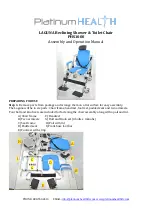
Removal: Turn the front lock (A) and the back lock (B)
in order to remove the armrest.
Lift up the armrest. Carry out this operation in
reverse order to replace the armrest. Remember
that the curved part of the tube should be facing
forward. Turn the front lock (A) and the lock (B) in
order to firmly secure the armrest to its locations.
Note: The armrest is reversible so that slot C can be used to hold an NHS
tray.
- Adjustment: This model does not require any adjustment.
Removable, swing away adjustable height armrest
Photographs 7 and 8
- The adjustable height armrest has a tube which supports the back
and front locks as well as the adjustable armpad tube. This armrest
can be swung towards the back and can be removed, if required.
- Use:
To swing away, turn the front lock (A) in
order to release. Lift the armrest and
position it towards the back in order to
carry out lateral transfers. Carry out these
operations in reverse order to replace the
armrest. Turn the front lock (A) in order to
firmly secure the armrest to its location.
Removal: Turn the front lock (A) and the back lock (B) in order to remove the
armrest.
Lift up the armrest. Carry out this operation in reverse order to replace the
armrest. Remember that the incurved part of the tube should be facing
forward. Turn the front lock (A) and the lock (B) in order to firmly secure the
armrest to its locations.
Height adjustment: Loosen the hand wheel
(D) and push in the button spring (E),
adjust to the desired height and tighten the
hand wheel (D). The hand wheel (D) can
be replaced by a screw (not included) for
users who do not often change the height
of the armrest.
21
20
8. Chassis
Side Frames
- The side frames provide the mounting points for the rear wheels
and the castors.
- Adjustment: No adjustment is possible on this series of wheelchair.
Folding cross brace
- The folding cross brace has two members which enable the
wheelchair to be folded.
- Adjustment: No adjustment is required. To fold or unfold your
wheelchair, refer to this user and safety manual.
9. Rear wheels
Wheels
Photograph 9
- The rear wheels are positioned on rear wheel mounting blocks
which determine the rearward stability This position should only be
adjusted by a qualified technician on the advise
of the qualified advisor.
The rear wheels have a diameter of either 600
mm, 550 mm, or 500 mm. They are equipped
with spokes and handrims. They can have
pneumatic tyres or solid tyres and can be
connected to the side frame by means of a
fixed axle or a quick release axle.
Tyre pressure.
The pressure is shown on the tyre and must never be exceeded. The
maximum permitted pressure is 450 kPa (65 PSI - 4.5 bar).
Remember that the tyre pressure on both wheels should be the same
to ensure perfect steering.
In case of a puncture, the tyre has to be removed from the rim. Press
the valve to let all the remaining air out of the inner tube. Pull the tyre
off the rim. Repair or replace the inner tube. Put the tyre back on the
rim. Inflate the tyre to the required pressure.
9
8
D
E
6
7
A
B
A
B
C
Summary of Contents for Zipper 2
Page 3: ......







































